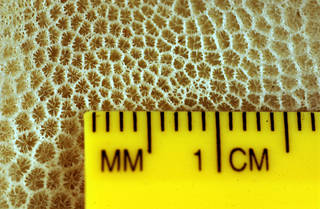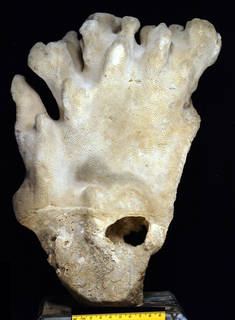
| Intro | | About | | Wiki | | Search traits | | Data explorer | | Literature | | Definitions | | Sources | | Webservices | | Statistics | | Feedback | | Editors | | Log in |
WoRMS taxon detailsAlveopora spongiosa Dana, 1846
207198 (urn:lsid:marinespecies.org:taxname:207198)
accepted
Species
Alveopora alcalai Nemenzo, 1976 · unaccepted > junior subjective synonym
Alveopora fijiensis Hoffmeister, 1932 · unaccepted > junior subjective synonym
Alveopora regularis Thiel, 1932 · unaccepted > junior subjective synonym
marine,
Dana, J.D. (1846-1849). Zoophytes. United States Exploring Expedition during the years 1838-1842. <em>Lea and Blanchard, Philadelphia.</em> 7: 1-740, 61 pls. (1846: 1-120, 709-720; 1848: 121-708, 721-740; 1849: atlas pls. 1-61)., available online at https://www.biodiversitylibrary.org/page/18989497, http://www.sil.si.edu/digitalcollections/usexex/navigation/ScientificText/USExEx19_08select.cfm [details]
Type locality contained in Fijian Exclusive Economic Zone
type locality contained in Fijian Exclusive Economic Zone [details]
Unreviewed
Type locality Fiji (Veron, 1986). [details]
Description This species grows mainly in the form of convoluted plates, with branch-like projections. Calices are rounded or angular,...
Description This species grows mainly in the form of convoluted plates, with branch-like projections. Calices are rounded or angular, and walls are highly porous, being formed from a weak lattice of spines. Calice diameters range between 1.5 and 1.9 mm, which is at the lower end of the range described for this species. Septa are composed of slender spines, mostly about half calice radius or less, but with some meeting in the central axis deeper in the calices. The top of the walls bear short, upward pointing spines. This is by far the commonest Alveopora, occurring in a variety of reef habitats. It is almost certain to be easily located between 20 - 50 m deep on fore reef slopes. (Sheppard, 1998 <308>). Colonies are thick plates or pillows with flat or undulating upper surface. Corallites are 1.9--2.6 mm in diameter, with long or short fine septal spines with seldom meet. Tips of polyp tentacles may be pointed or knob-like. Sometimes six large tentacles alternate with six small ones. Colour: usually uniform pale or dark brown, rarely green. Polyps sometimes have white tentacle tips. Abundance: Usually uncommon but colonies may be over 1m across in protected parts of upper reef slopes, and are conspicuous. (Veron, 1986 <57>) [details]
Hoeksema, B. W.; Cairns, S. (2025). World List of Scleractinia. Alveopora spongiosa Dana, 1846. Accessed through: World Register of Marine Species at: https://www.marinespecies.org/aphia.php?p=taxdetails&id=207198 on 2025-07-15
Date action by
Nomenclatureoriginal description
Dana, J.D. (1846-1849). Zoophytes. United States Exploring Expedition during the years 1838-1842. <em>Lea and Blanchard, Philadelphia.</em> 7: 1-740, 61 pls. (1846: 1-120, 709-720; 1848: 121-708, 721-740; 1849: atlas pls. 1-61)., available online at https://www.biodiversitylibrary.org/page/18989497, http://www.sil.si.edu/digitalcollections/usexex/navigation/ScientificText/USExEx19_08select.cfm [details] original description (of Alveopora fijiensis Hoffmeister, 1932) Hoffmeister JE (1932). Corals. In: Geology of Eua, Tonga. Bernice P. Bishop Museum Bulletin 96: 1-93, pl. 22. [details] original description (of Alveopora regularis Thiel, 1932) Thiel, M.E. (1932). Madreporaria. Zugleich ein Versuch einer vergleichenden Oekologie der gefundenen Formen. Resultats scientifiques du Voyage aux Indes Orientales Neerlandaises. <em>Memoires du Musée Royal d'Histoire Naturelle de Belgique.</em> 2(12): 1-177, pls. 1-21. [details] Available for editors original description (of Alveopora alcalai Nemenzo, 1976) Nemenzo, F. 1976. Some new Philippine scleractinian reef corals. Natural and Applied Science Bulletin, University of the Philippines 28: 229-276, pls. 1-10. [details] basis of record Veron JEN. (1986). Corals of Australia and the Indo-Pacific. <em>Angus & Robertson Publishers.</em> [details] Othercontext source (Hexacorallia)
Fautin, Daphne G. (2013). Hexacorallians of the World. (look up in IMIS) [details]
additional source Dana JD. (1872). Corals and coral islands. <em>Dodd & Mead, New York.</em> 398 pp. page(s): 77 [details] additional source Quelch J.J. (1886). Report on the Reef-corals collected by H.M.S. 'Challenger' during the years 1873-76. <em>Report on the Scientific Results of the Voyage of H.M.S. Challenger during the years 1873–1876. Zoology.</em> 16 (46): 1-203, pls 1-12., available online at http://www.19thcenturyscience.org/HMSC/HMSC-Reports/Zool-46/README.htm page(s): 20, 195 [details] additional source Dana, J.D. (1846-1847). On Zoophytes. <em>The American Journal of Science and Arts, Second Series.</em> 2(4): 64-69; 2(5): 187-202; 3(7): 1-24; 3(8): 160-163; 3(9): 337-347. New-Haven., available online at https://www.biodiversitylibrary.org/page/28135503 page(s): 511, 512, 513 [details] additional source Cairns, S.D., B.W. Hoeksema & J. van der Land. (1999). Appendix: List of extant stony corals. <em>Atoll Research Bulletin.</em> 459: 13-46. page(s): 37 [details] additional source Cairns, S.D., B.W. Hoeksema & J. van der Land. (2007). as a contribution to UNESCO-IOC Register of Marine Organisms. (look up in IMIS) [details] additional source Liu, J.Y. [Ruiyu] (ed.). (2008). Checklist of marine biota of China seas. <em>China Science Press.</em> 1267 pp. (look up in IMIS) [details] Available for editors additional source Veron JEN. (2000). Corals of the World. Vol. 1–3. <em>Australian Institute of Marine Science and CRR, Queensland, Australia.</em> [details] additional source Cairns, S.D., L. Gershwin, F.J. Brook, P. Pugh, E.W. Dawson, O.V. Ocaña, W. Vervoort, G. Williams, J.E. Watson, D.M. Opresko, P. Schuchert, P.M. Hine, D.P. Gordon, H.I. Campbell, A.J. Wright, J.A.Sánchez & D.G. Fautin. (2009). Phylum Cnidaria: corals, medusae, hydroids, myxozoans. <em>in: Gordon, D.P. (Ed.) (2009). New Zealand inventory of biodiversity: 1. Kingdom Animalia: Radiata, Lophotrochozoa, Deuterostomia.</em> :59-101., available online at https://repository.si.edu/handle/10088/8431 [details] Available for editors additional source Veron JEN, Pichon M. (1982). Scleractinia of Eastern Australia – Part IV. Family Poritidae. <em>Australian Institute of Marine Science Monograph Series.</em> 5: 1-159. [details] additional source Pichon, M.; Benzoni, F. (2007). Taxonomic re-appraisal of zooxanthellate Scleractinian Corals in the Maldive Archipelago. <em>Zootaxa.</em> 1441: 21–33. page(s): 31 [details] additional source Veron JEN, Marsh LM. (1988). Hermatypic corals of Western Australia : records and annotated species list. <em>Records Western Australian Museum Supplement.</em> 29: 1-136., available online at https://doi.org/10.5962/bhl.title.60555 page(s): 27, 72 [details] additional source Veron, J. E. N. (2000). Corals of the World, Volume III: Families Mussidae, Faviidae, Trachyphylliidae, Poritidae. Australian Institute of Marine Science. Townsville., volume 3, pp. 490. page(s): 388-389 [details] additional source Wallace, C. C.; Fellegara, I.; Muir, P. R.; Harrison, P. L. (2009). The scleractinian corals of Moreton Bay, eastern Australia: high latitude, marginal assemblages with increasing species richness. Memoirs of the Queensland Museum, 54, 2 page(s): 9 [details]  Present Present  Present in aphia/obis/gbif/idigbio Present in aphia/obis/gbif/idigbio  Inaccurate Inaccurate  Introduced: alien Introduced: alien  Containing type locality Containing type locality
Nontype WAM 144-88, geounit Australian Exclusive Economic Zone [details]
Nontype WAM 152-78, geounit Australian Exclusive Economic Zone [details]
Nontype WAM 220-78, geounit Australian Exclusive Economic Zone [details]
Nontype WAM 221-78, geounit Australian Exclusive Economic Zone [details]
Nontype WAM 270-84, geounit Australian Exclusive Economic Zone [details]
Nontype WAM 273-84, geounit Australian Exclusive Economic Zone [details]
Nontype WAM 274-84, geounit Australian Exclusive Economic Zone [details]
Nontype WAM 354-83, geounit Australian Exclusive Economic Zone [details]
Nontype WAM 423-77, geounit Australian Exclusive Economic Zone [details]
Nontype WAM 424-77, geounit Australian Exclusive Economic Zone [details]
Nontype WAM 463-85, geounit Australian Exclusive Economic Zone [details]
Nontype WAM 485-85, geounit Australian Exclusive Economic Zone [details]
Nontype WAM 486-85, geounit Australian Exclusive Economic Zone [details]
Nontype WAM 511-79, geounit Australian Exclusive Economic Zone [details]
Nontype WAM 547-86, geounit Ashmore-Cartier Is. [details]
Nontype WAM 587-78, geounit Australian Exclusive Economic Zone [details]
Nontype WAM 590-86, geounit Ashmore-Cartier Is. [details]
Nontype WAM 619-86, geounit Ashmore-Cartier Is. [details]
Nontype WAM 670-86, geounit Ashmore-Cartier Is. [details]
Nontype WAM 902-85, geounit Australian Exclusive Economic Zone [details]
Nontype WAM 924-85, geounit Australian Exclusive Economic Zone [details]
Nontype WAM 928-85, geounit Australian Exclusive Economic Zone [details]
From editor or global species database
Biology zooxanthellate [details]Unreviewed
Description This species grows mainly in the form of convoluted plates, with branch-like projections. Calices are rounded or angular, and walls are highly porous, being formed from a weak lattice of spines. Calice diameters range between 1.5 and 1.9 mm, which is at the lower end of the range described for this species. Septa are composed of slender spines, mostly about half calice radius or less, but with some meeting in the central axis deeper in the calices. The top of the walls bear short, upward pointing spines. This is by far the commonest Alveopora, occurring in a variety of reef habitats. It is almost certain to be easily located between 20 - 50 m deep on fore reef slopes. (Sheppard, 1998 <308>).Colonies are thick plates or pillows with flat or undulating upper surface. Corallites are 1.9--2.6 mm in diameter, with long or short fine septal spines with seldom meet. Tips of polyp tentacles may be pointed or knob-like. Sometimes six large tentacles alternate with six small ones. Colour: usually uniform pale or dark brown, rarely green. Polyps sometimes have white tentacle tips. Abundance: Usually uncommon but colonies may be over 1m across in protected parts of upper reef slopes, and are conspicuous. (Veron, 1986 <57>) [details] Type locality Fiji (Veron, 1986). [details]
To Barcode of Life (4 barcodes)
To Biodiversity Heritage Library (34 publications) To Biological Information System for Marine Life (BISMaL) To European Nucleotide Archive, ENA (Alveopora spongiosa) To GenBank (8 nucleotides; 4 proteins) To IUCN Red List (Vulnerable) To NMNH Extant Collection (IZCOE319verycloseup) To NMNH Extant Collection (IZCOE319wholecolony) To USNM Invertebrate Zoology Cnidaria Collection (12 records) To USNM Invertebrate Zoology Cnidaria Collection (3 records) (from synonym Alveopora fijiensis Hoffmeister, 1932) To USNM Invertebrate Zoology Cnidaria Collection (Holotype USNM 319) To USNM Invertebrate Zoology Cnidaria Collection (Holotype USNM 62493) (from synonym Alveopora fijiensis Hoffmeister, 1932) To ITIS |


